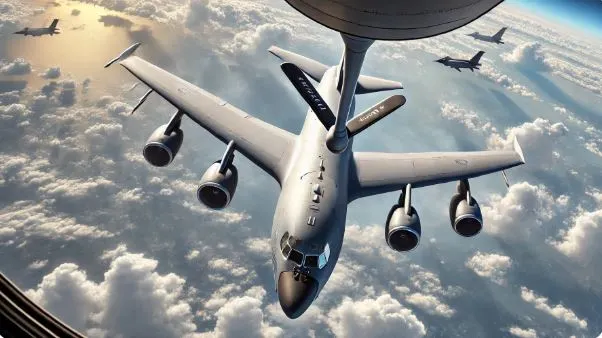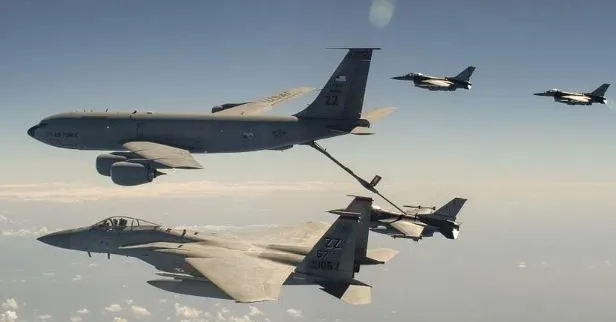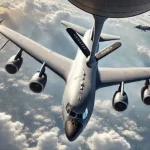Mid-air refueling, also known as aerial refueling or in-flight refueling (IFR), is a critical capability that allows military and specialized aircraft to extend their operational range and endurance without landing. This process involves the transfer of fuel from a tanker aircraft to a receiving aircraft while both are in flight. It is a complex operation that requires precision, coordination, and specialized equipment.
This article provides a detailed explanation of mid-air refueling, covering its methods, equipment, challenges, safety protocols, and operational significance.
History of Mid-Air Refueling
The concept of aerial refueling dates back to the early 20th century. The first recorded attempt was in 1923, using a crude hose system between two De Haviland DH-4B aircraft. Over the decades, advancements in technology led to the development of more efficient and reliable refueling systems. Today, aerial refueling is a standard capability in many air forces worldwide, playing a crucial role in strategic operations.
Methods of Aerial Refueling
There are two primary methods used for in-flight refueling:
1. Boom Refueling System
- Used primarily by the U.S. Air Force.
- Involves a rigid, telescoping boom that extends from the tanker to the receiving aircraft.
- A trained boom operator controls the boom from the tanker to guide it into the refueling receptacle of the receiving aircraft.
- Provides a higher fuel transfer rate, making it ideal for large aircraft like bombers and cargo planes.
2. Probe-and-Drogue System
- Used by the U.S. Navy, Marine Corps, and most NATO allies.
- Involves a flexible hose with a drogue (a funnel-shaped basket) at the end, which stabilizes the connection.
- The receiving aircraft has a probe that must make contact with the drogue to initiate refueling.
- More versatile, allowing multiple aircraft to refuel simultaneously if the tanker has multiple hoses.
Equipment Involved
Mid-air refueling requires specialized equipment on both the tanker and the receiving aircraft:
Tanker Aircraft
- Designed or modified to carry and transfer fuel.
- Equipped with either a boom or probe-and-drogue system.
- Common examples include the KC-135 Stratotanker, KC-10 Extender, and KC-46 Pegasus.
Receiver Aircraft
- Fitted with a refueling receptacle (for boom system) or a probe (for probe-and-drogue system).
- Fighters, bombers, cargo aircraft, and even helicopters can be equipped for aerial refueling.
Refueling Pods and External Systems
- Some aircraft, such as the KC-130, use wing-mounted refueling pods for probe-and-drogue operations.
- Buddy refueling systems allow fighter aircraft to refuel each other using external fuel tanks and hoses.
Challenges of Aerial Refueling
Mid-air refueling is a highly skilled operation with numerous challenges, including:
1. Precision and Coordination
- The receiver pilot must precisely maneuver to align with the tanker while maintaining stable flight.
- The boom operator or receiver pilot must ensure a successful connection.
2. Weather Conditions
- Turbulence, crosswinds, and poor visibility can make refueling dangerous.
- Tankers and receivers often operate under strict weather guidelines to ensure safety.
3. Airspace and Security
- Refueling operations often occur over secure airspace, away from enemy threats.
- Tactical planning ensures that refueling does not compromise mission secrecy or expose aircraft to attacks.
4. Fuel Transfer Limitations
- The tanker’s fuel capacity and range determine how much fuel it can provide before needing to refuel itself.
- Aircraft must plan their fuel loads efficiently to optimize mission capabilities.
Safety Measures in Aerial Refueling
Due to the complexity and risks involved, aerial refueling requires strict safety protocols:
- Pre-mission Briefing: Pilots and crew discuss flight plans, refueling altitudes, and emergency procedures.
- Communication: Continuous radio communication between the tanker and receiver aircraft ensures safe operations.
- Emergency Disconnect Procedures: Systems are in place for quick disconnection in case of turbulence, system failure, or sudden maneuvering.
- Training: Pilots and boom operators undergo extensive training, often using simulators before live refueling missions.
Importance of Mid-Air Refueling
Aerial refueling provides several strategic advantages, including:
- Extended Range: Aircraft can remain airborne for prolonged missions without landing.
- Increased Mission Flexibility: Refueling allows rapid response to dynamic operational requirements.
- Force Projection: Enables military forces to operate globally without relying on forward airbases.
- Operational Readiness: Reduces the need for frequent takeoffs and landings, saving time and resources.
Future of Aerial Refueling
Technological advancements continue to improve aerial refueling operations. Future developments include:
- Autonomous Refueling: Research is underway to enable UAVs (unmanned aerial vehicles) to refuel autonomously.
- Increased Efficiency: New tanker designs focus on higher fuel capacity and longer endurance.
- Improved Safety Measures: AI-assisted guidance systems are being tested to enhance refueling precision.
Conclusion
Mid-air refueling is a vital capability that extends the operational reach of military aircraft, ensuring sustained airpower and mission effectiveness. While it remains a challenging and complex task, advancements in technology and rigorous training continue to enhance its efficiency and safety. As aerial refueling technology evolves, it will play an even more critical role in future air combat and strategic operations.




